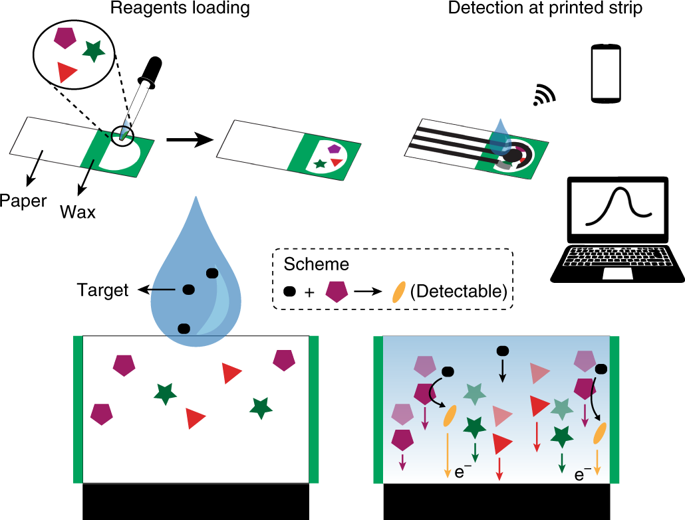Nature Protocols ( IF 13.1 ) Pub Date : 2019-07-03 , DOI: 10.1038/s41596-019-0186-y Stefano Cinti 1 , Danila Moscone 2 , Fabiana Arduini 2

|
Despite substantial advances in sensing technologies, the development, preparation, and use of self-testing devices is still confined to specialist laboratories and users. Decentralized analytical devices will enormously impact daily lives, enabling people to analyze diverse clinical, environmental, and food samples, evaluate them and make predictions to improve quality of life, particularly in remote, resource-scarce areas. In recent years, paper-based analytical tools have attracted a great deal of attention; the well-known properties of paper, such as abundance, affordability, lightness, and biodegradability, combined with features of printed electrochemical sensors, have enabled the development of sustainable devices that drive (bio)sensors beyond the state of the art. Their blindness toward colored/turbid matrices (i.e., blood, soil), their portability, and the capacity of paper to autonomously filter/purge/react with target species make such devices powerful in establishing point-of-need tools for use by non-specialists. This protocol describes the preparation of a voltammetric phosphate sensor and an amperometric nerve agent biosensor; both platforms produce quantitative measurements with currents in the range of microamperes. These printed strips comprise three electrodes (graphite for working and counter electrodes and silver/silver chloride (Ag/AgCl) for the reference electrode) and nanomodifiers (carbon black and Prussian blue) to improve their performance and specificity. Depending on analytical need, different types of paper (filter, office) and configurations (1D, 2D, 3D) can be adopted. The protocol, based on the use of cost-effective manufacturing techniques such as drop casting (to chemically modify the substrate surface) and wax/screen printing (for creating the channels and electrodes), can be completed in <1 h.
中文翻译:

用于无试剂电化学(生物)传感条的纸基装置的制备
尽管传感技术取得了重大进展,但自测设备的开发、准备和使用仍仅限于专业实验室和用户。分散式分析设备将极大地影响日常生活,使人们能够分析各种临床、环境和食品样本,对其进行评估并做出预测,以提高生活质量,尤其是在偏远、资源稀缺的地区。近年来,基于纸张的分析工具备受关注;纸张众所周知的特性,例如丰富性、可负担性、轻便性和生物降解性,结合印刷电化学传感器的特性,使可持续设备的发展成为可能,从而推动(生物)传感器超越最先进的技术水平。他们对有色/混浊基质(即血液、土壤)视而不见,它们的便携性以及纸张自主过滤/清除/与目标物种反应的能力使这些设备在建立供非专业人员使用的即时工具方面非常强大。该协议描述了伏安磷酸盐传感器和安培神经毒剂生物传感器的制备;两个平台都使用微安范围内的电流进行定量测量。这些印刷条包括三个电极(石墨用于工作电极和对电极,银/氯化银 (Ag/AgCl) 用于参比电极)和纳米改性剂(炭黑和普鲁士蓝),以提高它们的性能和特异性。根据分析需要,可以采用不同类型的纸张(过滤器、办公室)和配置(1D、2D、3D)。该协议,











































 京公网安备 11010802027423号
京公网安备 11010802027423号